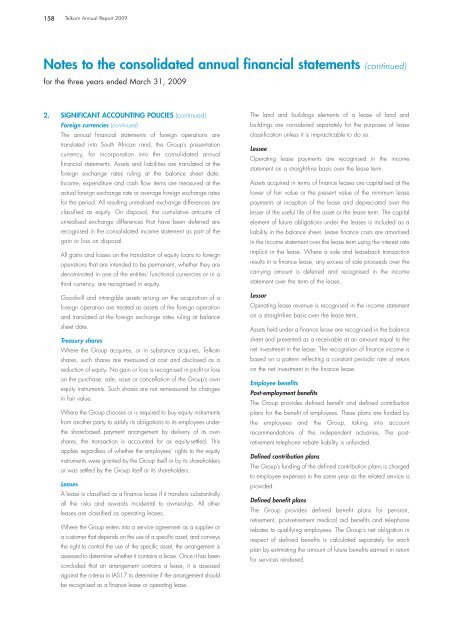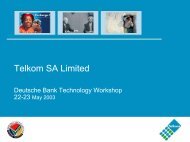Telkom AR front.qxp
Telkom AR front.qxp
Telkom AR front.qxp
Create successful ePaper yourself
Turn your PDF publications into a flip-book with our unique Google optimized e-Paper software.
158<br />
<strong>Telkom</strong> Annual Report 2009<br />
Notes to the consolidated annual financial statements (continued)<br />
for the three years ended March 31, 2009<br />
2. SIGNIFICANT ACCOUNTING POLICIES (continued)<br />
Foreign currencies (continued)<br />
The annual financial statements of foreign operations are<br />
translated into South African rand, the Group’s presentation<br />
currency, for incorporation into the consolidated annual<br />
financial statements. Assets and liabilities are translated at the<br />
foreign exchange rates ruling at the balance sheet date.<br />
Income, expenditure and cash flow items are measured at the<br />
actual foreign exchange rate or average foreign exchange rates<br />
for the period. All resulting unrealised exchange differences are<br />
classified as equity. On disposal, the cumulative amounts of<br />
unrealised exchange differences that have been deferred are<br />
recognised in the consolidated income statement as part of the<br />
gain or loss on disposal.<br />
All gains and losses on the translation of equity loans to foreign<br />
operations that are intended to be permanent, whether they are<br />
denominated in one of the entities’ functional currencies or in a<br />
third currency, are recognised in equity.<br />
Goodwill and intangible assets arising on the acquisition of a<br />
foreign operation are treated as assets of the foreign operation<br />
and translated at the foreign exchange rates ruling at balance<br />
sheet date.<br />
Treasury shares<br />
Where the Group acquires, or in substance acquires, <strong>Telkom</strong><br />
shares, such shares are measured at cost and disclosed as a<br />
reduction of equity. No gain or loss is recognised in profit or loss<br />
on the purchase, sale, issue or cancellation of the Group’s own<br />
equity instruments. Such shares are not remeasured for changes<br />
in fair value.<br />
Where the Group chooses or is required to buy equity instruments<br />
from another party to satisfy its obligations to its employees under<br />
the share-based payment arrangement by delivery of its own<br />
shares, the transaction is accounted for as equity-settled. This<br />
applies regardless of whether the employees’ rights to the equity<br />
instruments were granted by the Group itself or by its shareholders<br />
or was settled by the Group itself or its shareholders.<br />
Leases<br />
A lease is classified as a finance lease if it transfers substantially<br />
all the risks and rewards incidental to ownership. All other<br />
leases are classified as operating leases.<br />
Where the Group enters into a service agreement as a supplier or<br />
a customer that depends on the use of a specific asset, and conveys<br />
the right to control the use of the specific asset, the arrangement is<br />
assessed to determine whether it contains a lease. Once it has been<br />
concluded that an arrangement contains a lease, it is assessed<br />
against the criteria in IAS17 to determine if the arrangement should<br />
be recognised as a finance lease or operating lease.<br />
The land and buildings elements of a lease of land and<br />
buildings are considered separately for the purposes of lease<br />
classification unless it is impracticable to do so.<br />
Lessee<br />
Operating lease payments are recognised in the income<br />
statement on a straight-line basis over the lease term.<br />
Assets acquired in terms of finance leases are capitalised at the<br />
lower of fair value or the present value of the minimum lease<br />
payments at inception of the lease and depreciated over the<br />
lesser of the useful life of the asset or the lease term. The capital<br />
element of future obligations under the leases is included as a<br />
liability in the balance sheet. Lease finance costs are amortised<br />
in the income statement over the lease term using the interest rate<br />
implicit in the lease. Where a sale and leaseback transaction<br />
results in a finance lease, any excess of sale proceeds over the<br />
carrying amount is deferred and recognised in the income<br />
statement over the term of the lease.<br />
Lessor<br />
Operating lease revenue is recognised in the income statement<br />
on a straight-line basis over the lease term.<br />
Assets held under a finance lease are recognised in the balance<br />
sheet and presented as a receivable at an amount equal to the<br />
net investment in the lease. The recognition of finance income is<br />
based on a pattern reflecting a constant periodic rate of return<br />
on the net investment in the finance lease.<br />
Employee benefits<br />
Post-employment benefits<br />
The Group provides defined benefit and defined contribution<br />
plans for the benefit of employees. These plans are funded by<br />
the employees and the Group, taking into account<br />
recommendations of the independent actuaries. The postretirement<br />
telephone rebate liability is unfunded.<br />
Defined contribution plans<br />
The Group’s funding of the defined contribution plans is charged<br />
to employee expenses in the same year as the related service is<br />
provided.<br />
Defined benefit plans<br />
The Group provides defined benefit plans for pension,<br />
retirement, post-retirement medical aid benefits and telephone<br />
rebates to qualifying employees. The Group’s net obligation in<br />
respect of defined benefits is calculated separately for each<br />
plan by estimating the amount of future benefits earned in return<br />
for services rendered.




